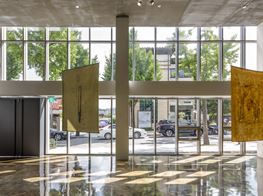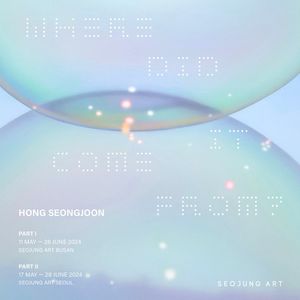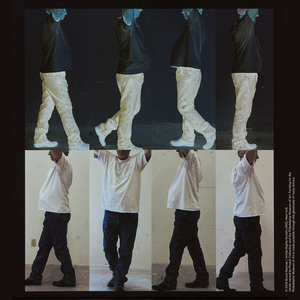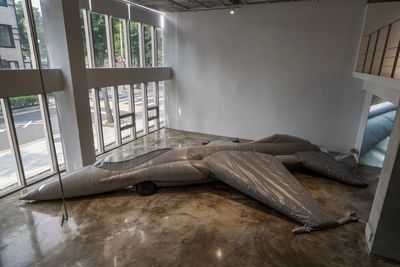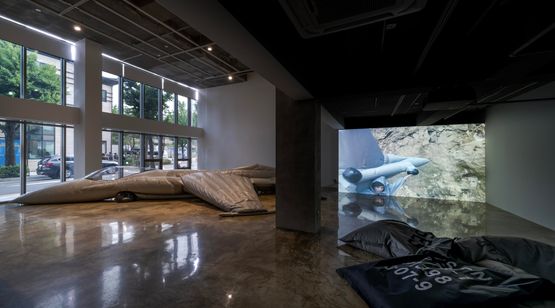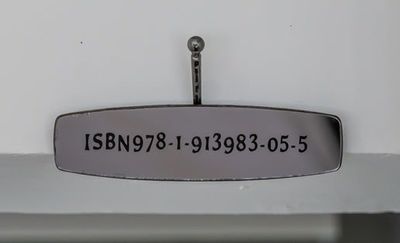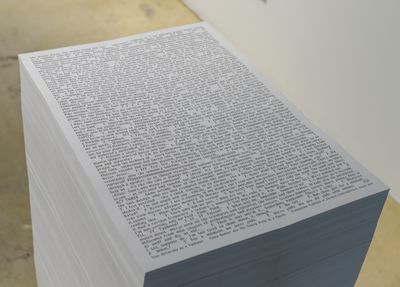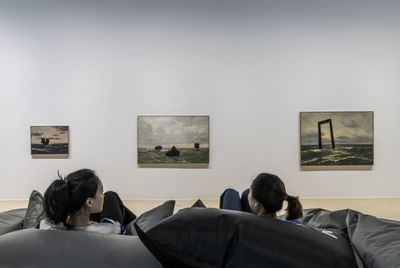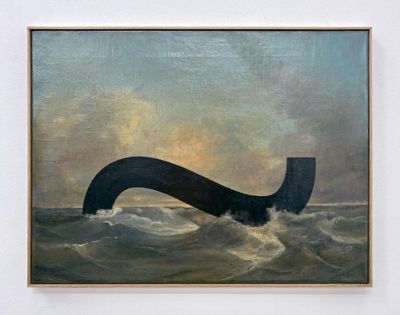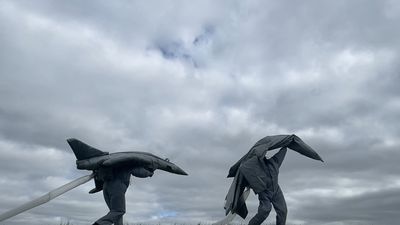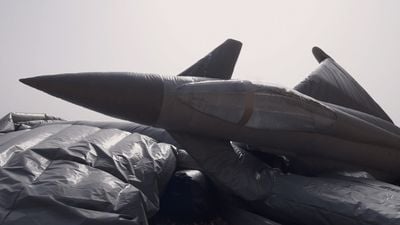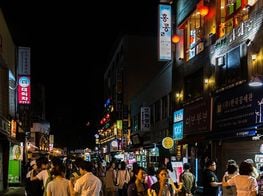Fiona Banner's Pranayama Typhoon Breathes Through a World in Crisis
Showing for the first time in Asia at Barakat Contemporary in Seoul (16 June–15 August 2021), Pranayama Typhoon consists of new video work and recent paintings and installations by British artist Fiona Banner, aka The Vanity Press.

Exhibition view: Fiona Banner aka The Vanity Press, Pranayama Typhoon, Barakat Contemporary, Seoul (16 June–15 August 2021). Courtesy the artist and Frith Street Gallery, London. Photo: Barakat Contemporary.
An inflatable decoy military aircraft, Falcon (2021), occupies half the gallery space on the first floor. The magnificent grey-coloured vinyl fighter plane has no one on board but is regularly puffed and deflated through an anal ventilator that breathes for it, causing its beak to grow and shrink.
Next to Falcon is a rear-view mirror work, GODS WITH ANUSES (ISBN 978-1-913983-05-5) (2021), hung on the upper part of the gallery wall: a sculpture as well as a publication with an official International Standard Book Number (ISBN) identifier for the book titled Gods with Anuses.
As the book notes, Falcon is a god with a rectum, and like its namesake, a bird of prey. But the specimen in the gallery is neither fast nor dangerous. It has been left to focus on its breathing as if engaged in the yogic practice of pranayama: a mirroring of the powerlessness felt during a human 'annus horribilis', when many must take deep breaths to cope.
In the video Pranayama Organ (2021), situated beside Falcon, the breathing god-aircraft becomes a protagonist alongside 'Typhoon': two decoy military aircraft that gradually inflate to become people dressed as fighter planes. These human-aircraft hybrids consume wind, rub their beaks, and dance around each other on a desolate beach: they are performing for themselves and enjoying it.
The mixed sound of breathing, a pipe organ, and traces of David Bowie's song 'Wild is the Wind' work well to frame this strange dance. The grand andominous music rises to a stimulating, rhythmical flow, mirroring the work's narrative: military aircraft, which usually evoke power and authority, can only fly after they consume the 'wild'.
The incongruity of two decoy military aircraft breathlessly dancing in human form, not to mention the juxtaposition of metal and flesh, is metaphorically transcribed in the sculpture-publication The Wood Decay, The Woods Decoy and Fall (2021), located on the second floor.
Printed on a stack of paper is a dialogue between Falcon and Typhoon, which could be seen as a dialogue among nature, disaster (Typhoon), and humankind (Falcon). But the stack is placed too high to read, the paper column's height visualising instead a long history of exploiting nature and the failure to properly appreciate the urgency of the climate crisis.
Like nature, Banner's monument-publication decays. People are allowed to take off one piece from the pile. Yet nobody made the attempt when I was in the gallery—an indifference, perhaps, that is metaphorically reflected in Bad Review (2021). Hung close to the entrance in the corner of the gallery's first floor, a car rear-view mirror seems to invite viewers to look again.
At once addressing specific subjects and erasing them, this holistic assemblage of works stimulates sensibilities by using a cross-section of vocabularies appropriated and reformed.
On the second floor, away from the beach of Pranayama Organ, the exhibition glides into the sea with a group of 'Full Stop' (2021) paintings installed low on the wall or hung low in the air. Viewed from a seated position, seascapes with black chunks—variations of a full stop in various fonts (Helvetica, Peanuts, Klang, and Orator) blown up—replace the ships.
These full stops do not seem to function as the endpoint. Rather, they erase the subject of interest to create empty spaces or portals: a possibility beyond what these erased ships generally signify, whether war, trade, wealth, and entertainment, not to mention human domination over nature.
In the middle of the gallery, these voids spill out into physical space with black beanbags on which their titles are painted in white: RECTO VERSO, CHAPTER LEAF, A HYPHEN, AN ISLAND (ISBN 978-1-913983-06-2), and VERSO RECTO (all 2021).
At once addressing specific subjects and erasing them, this holistic assemblage of works stimulates sensibilities by using a cross-section of vocabularies appropriated and reformed. Much of Banner's work is about rearranging the form of language, thus transforming its function and meaning.
Also known as The Vanity Press—the artist's moniker and imprint, which comes from a term that signals an author assumes all the risks in publishing—Banner's work transmits through various formats like an expanded text, while also highlighting the way in which actual or imagined events are fictionalised and mythologised.
As Virginia Button noted in 1998, on the occasion of Banner's Art Now show at Tate Britain, 'Banner is fascinated by the near impossibility of containing action and time in a prescribed form', and 'is best known for making hand-written and printed texts "wordscapes" or "still films", that retell in her own words entire feature films or sequences of events.'1
Early examples include the graphite on paper transcriptions of Top Gun (Top Gun, 1994) and Lawrence of Arabia (Desert, 1994), created when Banner was included in General Release: Young British Artists at the British Pavilion for the 46th Venice Biennale in 1995, which culminated with THE NAM (1997).
THE NAM originated in work Banner created for the 1996 Spellbound: Art and Film show at Hayward Gallery, which included a large-scale hand-written transcription of Apocalypse Now and a drawing of a Chinook helicopter.
The book comprises Banner's continuous text describing Vietnam war movies Apocalypse Now, Born on the Fourth of July, The Deer Hunter, Full Metal Jacket, Hamburger Hill, and Platoon, which is read aloud unabridged in the 20-hour, 22 cassette Trance.2
The induction of a state of hypnosis and disruption of perspective is perhaps the link between works like THE NAM and Pranayama Organ's windy seascape in Seoul. Objects and texts act like points on a map: inflated military aircraft glorified into absurd gods, punctuations caught at sea, open and obscure objects, and breathing bodies.
In 1962, British writer J.G. Ballard's novel The Drowned World envisioned an apocalyptic time when a tropical, overheated London has flooded and is barely inhabitable in a world ravaged by climate catastrophe, as human beings are transformed physically and psychologically before eventually dying out.
Banner's deep and windy seascape is like the sign of this flood. Centred in a world that is vulnerable, tragic, and farcical—hard to place—Falcon and Typhoon ask in The Wood Decay, The Woods Decoy and Fall: 'where we are now?' A world in danger feels palpable. —[O]
1 Only the Lonely: Fiona Banner, Bridget Smith exhibition catalogue, Frith Street Gallery, 1997, p.13.
2 Virginia Button, 'Art Now: Fiona Banner', Tate Britain, 1998, https://www.tate.org.uk/whats-on/tate-britain/exhibition/art-now-fiona-banner


